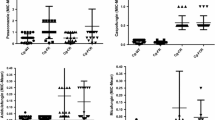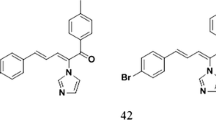Abstract
Here, we evaluated combinations of diphenyl diselenide [(PhSe)2] with fluconazole and amphotericin B in a checkerboard assay against clinical Candida glabrata strains. Minimal inhibitory concentration (geometric mean) ranged from 0.25 to >64 (5.16 μg/mL) for (PhSe)2, 1 to 32 (5.04 μg/mL) for fluconazole and 0.06 to 0.5 (0.18 μg/mL) for amphotericin B. Synergistic (76.66 %) and indifferent (23.34 %) interactions were observed for (PhSe)2 + amphotericin B combination. (PhSe)2 + fluconazole combination demonstrated indifferent (50 %) and antagonistic (40 %) interactions, whereas synergistic interactions were observed in 10 % of the isolates. New experimental in vivo protocols are necessary and will promote a better understanding of the antimicrobial activity of (PhSe)2 against C. glabrata and its use as an adjuvant therapy with antifungal agents.
Similar content being viewed by others
References
Silva S, Negri M, Henriques M, Oliveira R, Williams DW, Azeredo J. Candida glabrata, Candida parapsilosis and Candida tropicalis: biology, epidemiology, pathogenicity and antifungal resistance. FEMS Microbiol Rev. 2012;36:288–305.
Eggimann P, Garbino J, Pittet D. Epidemiology of Candida species infections in critically ill non-immunosuppressed patients. Lancet Infect Dis. 2003;3:685–702.
Horn DL, Neofytos D, Anaissie EJ, Fishman JA, Steinbach WJ, Olyaei AJ, et al. Epidemiology and outcomes of candidemia in 2019 patients: data from the prospective antifungal therapy alliance registry. Clin Infect Dis. 2009;48:1695–703.
Pfaller MA, Castanheira M, Messer SA, Moet GJ, Jones RN. Variation in Candida spp. distribution and antifungal resistance rates among bloodstream infection isolates by patient age: report from the SENTRY Antimicrobial Surveillance Program (2008–2009). Diagn Microbiol Infect Dis. 2010;68:278–83.
Furlaneto-Maia L, Specian AF, Bizerra FC, de Oliveira MT, Furlaneto MC. In vitro evaluation of putative virulence attributes of oral isolates of Candida spp. obtained from elderly healthy individuals. Mycopathologia. 2008;166:209–17.
Azevedo AC, Bizerra FC, da Matta DA, de Almeida LP, Rosas R, Colombo AL. In vitro susceptibility of a large collection of Candida strains against fluconazole and voriconazole by using the CLSI disk diffusion assay. Mycopathologia. 2011;171:411–6.
Passos XS, Costa CR, Araujo CR, Nascimento ES, Souza LKHE, Fernandes ODL, et al. Species distribution and antifungal susceptibility patterns of Candida spp. bloodstream isolates from a Brazilian tertiary care hospital. Mycopathologia. 2007;163:145–51.
Fidel PL, Vazquez JA, Sobel JD. Candida glabrata: review of epidemiology, pathogenesis, and clinical disease with comparison to C. albicans. Clin Microbiol Rev. 1999;12:80–96.
Pfaller MA, Messer SA, Hollis RJ, Boyken L, Tendolkar S, Kroeger J, et al. Variation in susceptibility of bloodstream isolates of Candida glabrata to Fluconazole according to patient age and geographic location in the United States in 2001–2007. J Clin Microbiol. 2009;47:3185–90.
Pfaller MA, Messer SA, Boyken L, Tendolkar S, Hollis RJ, Diekema DJ. Geographic variation in the susceptibilities of invasive isolates of Candida glabrata to seven systemically active antifungal agents: a global assessment from the ARTEMIS antifungal surveillance program conducted in 2001 and 2002. J Clin Microbiol. 2004;42:3142–6.
Sellami A, Sellami H, Neji S, Makni F, Abbes S, Cheikhrouhou F, et al. Antifungal susceptibility of bloodstream Candida isolates in Sfax Hospital: Tunisia. Mycopathologia. 2011;171:417–22.
Bonfietti LX, Szeszs MW, Chang MR, Martins MA, Pukinskas SRBS, Nunes MO, et al. Ten-year study of species distribution and antifungal susceptibilities of Candida bloodstream isolates at a Brazilian tertiary hospital. Mycopathologia. 2012;174:389–96.
Metin DY, Hilmioglu-Polat S, Samlioglu P, Doganay-Oflazoglu B, Inci R, Tumbay E. Evaluation of antifungal susceptibility testing with microdilution and Etest methods of Candida blood isolates. Mycopathologia. 2011;172:187–99.
Campbell BC, Chan KL, Kim JH. Chemosensitization as a means to augment commercial antifungal agents. Front Microbiol. 2012;3:79.
Khodavandi A, Alizadeh F, Aala F, Sekawi Z, Chong PP. In vitro investigation of antifungal activity of allicin alone and in combination with azoles against Candida species. Mycopathologia. 2010;169:287–95.
Nogueira CW, Zeni G, Rocha JB. Organoselenium and organotellurium compounds: toxicology and pharmacology. Chem Rev. 2004;104:6255–85.
Nogueira CW, Rocha JBT. Diphenyl diselenide a Janus-faced molecule. J Braz Chem Soc. 2010;21:2055–71.
Nogueira CW, Rocha JBT. Toxicology and pharmacology of selenium: emphasis on synthetic organoselenium compounds. Arch Toxicol. 2011;85:1313–59.
Loreto ES, Mario DA, Santurio JM, Alves SH, Nogueira CW, Zeni G. In vitro antifungal evaluation and structure-activity relationship of diphenyl diselenide and synthetic analogues. Mycoses. 2011;54:e572–6.
Rosseti IB, Wagner C, Fachinetto R, Taube P, Costa MS. Candida albicans growth and germ tube formation can be inhibited by simple diphenyl diselenides [(PhSe)2, (MeOPhSe)2, (p–Cl–PhSe)2, (F3CPhSe)2] and diphenyl ditelluride. Mycoses. 2011;54:506–13.
Loreto ES, Alves SH, Santurio JM, Nogueira CW, Zeni G. Diphenyl diselenide in vitro and in vivo activity against the oomycete Pythium insidiosum. Vet Microbiol. 2012;156:222–6.
Billack B, Santoro M, Lau-Cam C. Growth inhibitory action of ebselen on fluconazole-resistant Candida albicans: role of the plasma membrane H+-ATPase. Microb Drug Resist. 2009;15:77–83.
Paulmier C. Selenoorganic functional groups. In: Paulmier C, editor. Selenium reagents and intermediates in organic synthesis. 1st ed. Oxford: Pergamon Press; 1986. p. 25–57.
Clinical and Laboratory Standards Institute. Reference method for broth dilution antifungal susceptibility testing of yeasts: approved standard. 3rd ed. Wayne: Clinical and Laboratory Standards Institute; 2008.
Johnson MD, MacDougall C, Ostrosky-Zeichner L, Perfect JR, Rex JH. Combination antifungal therapy. Antimicrob Agents Chemother. 2004;48:693–715.
Meotti FC, Borges VC, Zeni G, Rocha JBT, Nogueira CW. Potential renal and hepatic toxicity of diphenyl diselenide, diphenyl ditelluride and Ebselen for rats and mice. Toxicol Lett. 2003;143:9–16.
Wilhelm EA, Jesse CR, Nogueira CW, Savegnago L. Introduction of trifluoromethyl group into diphenyl diselenide molecule alters its toxicity and protective effect against damage induced by 2-nitropropane in rats. Exp Toxicol Pathol. 2009;61:197–203.
Krcmery V, Barnes AJ. Non-albicans Candida spp. causing fungaemia: pathogenicity and antifungal resistance. J Hosp Infect. 2002;50:243–60.
Mario DAN, Denardi LB, Bandeira LA, Antunes MS, Santurio JM, Severo LC, et al. The activity of echinocandins, amphotericin B and voriconazole against fluconazole-susceptible and fluconazole-resistant Brazilian Candida glabrata isolates. Mem Inst Oswaldo Cruz. 2012;107:433–6.
Denning DW, Baily GG, Hood SV. Azole resistance in Candida. Eur J Clin Microbiol Infect Dis. 1997;16:261–80.
Sanguinetti M, Posteraro B, Fiori B, Ranno S, Torelli R, Fadda G. Mechanisms of azole resistance in clinical isolates of Candida glabrata collected during a hospital survey of antifungal resistance. Antimicrob Agents Chemother. 2005;49:668–79.
Bennett JE, Izumikawa K, Marr KA. Mechanism of increased fluconazole resistance in Candida glabrata during prophylaxis. Antimicrob Agents Chemother. 2004;48:1773–7.
Johnson LB, Kauffman CA. Voriconazole: a new triazole antifungal agent. Clin Infect Dis. 2003;36:630–7.
Marcos-Arias C, Eraso E, Madariaga L, Carrillo-Munoz AJ, Quindos G. In vitro activities of new triazole antifungal agents, posaconazole and voriconazole, against oral Candida isolates from patients suffering from denture stomatitis. Mycopathologia. 2012;173:35–46.
Pfaller MA, Messer SA, Boyken L, Rice C, Tendolkar S, Hollis RI, et al. Use of fluconazole as a surrogate marker to predict susceptibility and resistance to voriconazole among 13,338 clinical isolates of Candida spp. tested by clinical and laboratory standards institute-recommended broth microdilution methods. J Clin Microbiol. 2007;45:70–5.
Cross EW, Park S, Perlin DS. Cross-resistance of clinical isolates of Candida albicans and Candida glabrata to over-the-counter azoles used in the treatment of vaginitis. Microb Drug Resist. 2000;6:155–61.
Alves IA, Bandeira LA, Mario DA, Denardi LB, Neves LV, Santurio JM, et al. Effects of antifungal agents alone and in combination against Candida glabrata strains susceptible or resistant to fluconazole. Mycopathologia. 2012;174:215–21.
Acknowledgments
Érico Silva de Loreto is financially supported by fellowships from Coordenação de Aperfeiçoamento de Pessoal de Nível Superior, Brazil (PNPD-CAPES).
Author information
Authors and Affiliations
Corresponding author
Rights and permissions
About this article
Cite this article
Denardi, L.B., Mario, D.A.N., de Loreto, É.S. et al. Antifungal Activities of Diphenyl Diselenide alone and in Combination with Fluconazole or Amphotericin B against Candida glabrata . Mycopathologia 176, 165–169 (2013). https://doi.org/10.1007/s11046-013-9672-x
Received:
Accepted:
Published:
Issue Date:
DOI: https://doi.org/10.1007/s11046-013-9672-x




